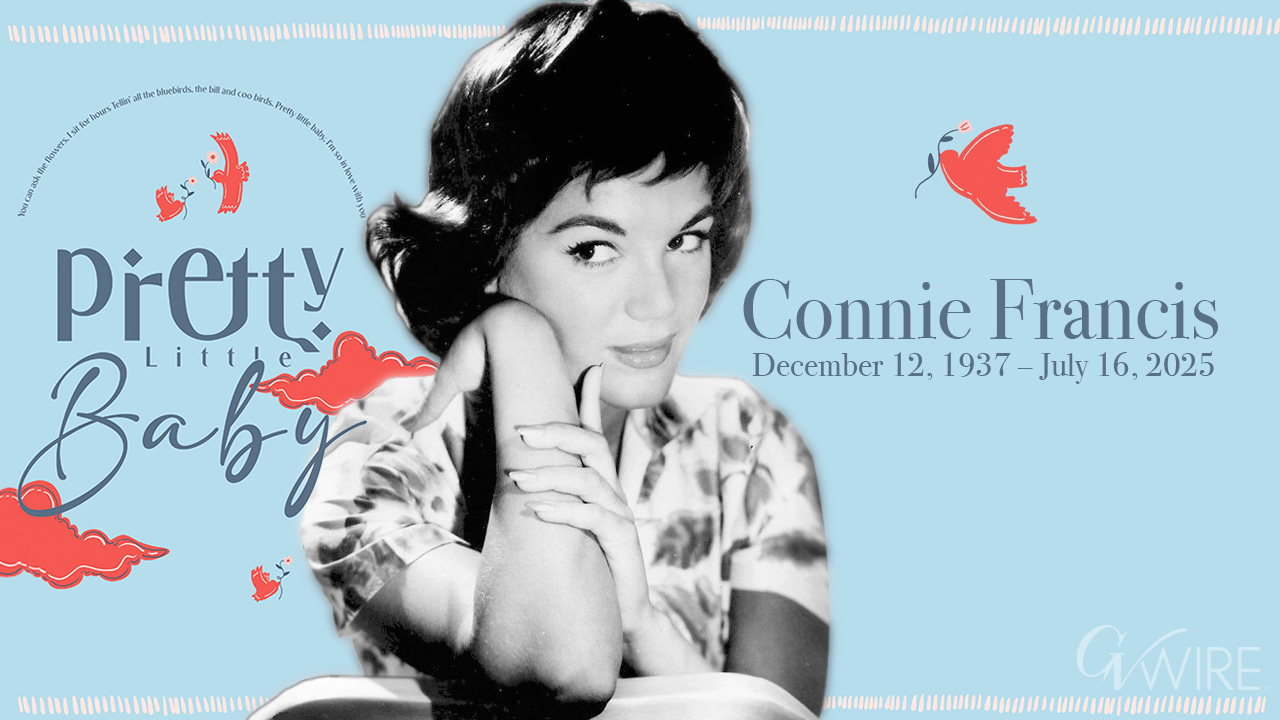Connie Francis, who dominated the pop charts in the late 1950s and early ’60s with sobbing ballads like “Who’s Sorry Now” and “Don’t Break the Heart That Loves You,” as well as up-tempo soft-rock tunes like “Stupid Cupid” and “Vacation,” died Wednesday, July 16, 2025. She was 87. (GV Wire Composite/Paul Marshall)

- Connie Francis dominated the pop charts in the late 1950s and early ’60s with sobbing ballads like “Who’s Sorry Now.”
- She died Wednesday at age 87, her publicist said on Facebook.
- Francis, a rape survivor, returned to Las Vegas as a headline act in 2004.
Share
|
Getting your Trinity Audio player ready...
|
Connie Francis, who dominated the pop charts in the late 1950s and early ’60s with sobbing ballads like “Who’s Sorry Now” and “Don’t Break the Heart That Loves You,” as well as up-tempo soft-rock tunes like “Stupid Cupid,” “Lipstick on Your Collar” and “Vacation,” died Wednesday. She was 87.
Her publicist, Ron Roberts, announced her death in a post on Facebook. He did not say where she died or cite a cause. Francis was hospitalized two weeks ago for extreme pain.
Francis had an easy, fluid vocal style, a powerful set of lungs and a natural way with a wide variety of material: old standards, rock ’n’ roll and country, as well as popular songs in Italian, Yiddish, Swedish and a dozen other languages.
Sold 40 Million Records 1958 to 1964
Between 1958 and 1964, when her brand of pop music began to fall out of favor, Francis was the most popular female singer in the United States, selling 40 million records. Her 35 Top 40 hits during that period included 16 songs that made the Billboard Top 10, and three No. 1 hits: “Everybody’s Somebody’s Fool” and “My Heart Has a Mind of Its Own” in 1960 and “Don’t Break the Heart That Loves You” in 1962.
She was best known for the pulsing, emotional delivery that coaxed every last teardrop from slow ballads like “Who’s Sorry Now” — the first of her many records to sell 1 million copies — and made “Where the Boys Are” a potent anthem of teenage longing. Sighing youngsters thrilled to every throb in “My Happiness” and “Among My Souvenirs.”
“What struck me was the purity of the voice, the emotion, the perfect pitch and intonation,” said Neil Sedaka, who wrote her hits “Stupid Cupid” and “Where the Boys Are” with Howard Greenfield. “It was clear, concise, beautiful. When she sang ballads, they just soared.”
‘Pretty Little Baby’ Trends on TikTok
Her song “Pretty Little Baby,” which was initially so obscure that Francis had forgotten ever recording it, had an unlikely resurgence this year, trending for weeks on TikTok and soaring to top spots in Spotify’s Viral 50 global and U.S. lists.
Concetta Franconero was born Dec. 12, 1937, in Newark, New Jersey, to George and Ida (Ferrari-di Vito) Franconero, and grew up in the city’s Ironbound neighborhood. Her father, the son of Italian immigrants, was a dockworker and a roofer who loved to play the concertina, and he put an accordion in his daughter’s hands when she was 3.
From that moment, he hovered over her musical development and her career, putting her onstage at local lodges and churches. She made her stage debut at 4, singing “Anchors Aweigh” and accompanying herself on the accordion at Olympic Park in Irvington, New Jersey.
At 11, she was a regular on “Marie Moser’s Starlets,” a local television variety show. After she appeared on Ted Mack’s “Original Amateur Hour” and “Arthur Godfrey’s Talent Scouts,” Mack advised her to lose the accordion, and Godfrey advised her to change her last name to Francis. She then embarked on a four-year run as one of the child entertainers on the anthology series “Startime.”
As she outgrew the child star category, Francis obtained forged documents and began singing in clubs and lounges. Imitating the vocal styles of stars like Patti Page and Rosemary Clooney, she made demonstration tapes for music publishers who wanted to place their songs with famous singers.
Career Begins With Flops
In 1955, she signed a contract with MGM Records, and over the next two years she recorded 10 singles, all of them flops. “The bombs just kept a-comin’,” she wrote in “Who’s Sorry Now?” her 1984 memoir (which, unlike the single and the subsequent album, used a question mark). “They were becoming my trademark, a foregone conclusion.”
Down to her last record and ready to quit show business to attend college, she gave in to her father’s wishes and recorded “Who’s Sorry Now,” a song she loathed because she thought it sounded old-fashioned. It was first heard on Dick Clark’s “American Bandstand” on Jan. 1, 1958, and sold 1 million copies in the next six months.
“It was the first time I ever recorded that I didn’t try to imitate somebody else,” Francis told Gary James in an interview for classicbands.com in 1994. “I hated the song so much that I didn’t care what I sounded like. So I just sang it.”
For the next four years, Francis reigned as queen of the charts, not only in the United States but around the world. She sang in foreign languages when required — her first such hit was “Mama” in 1960, recorded after she learned Italian — and released albums including “Connie Francis Sings Italian Favorites,” “Connie Francis Sings Jewish favorites” and “Connie Francis Sings Irish Favorites.”
Like singer and songwriter Bobby Darin, with whom she was romantically involved until her father chased him off with a gun, when she was in her late teens, Francis reached out beyond her teenage audience, recording material that made her a natural in Las Vegas as well as in nightclubs like the Copacabana in New York. She was also a sought-after entertainer on television variety shows.
She briefly tried performing before teenage audiences, but she found that she did not care for the experience.
“I always remember receiving much more applause from teenagers when I was introduced than at any other time during the show — especially after my closing number,” she wrote in her memoir. “After my name was announced and the squeals of delight subsided, it was downhill all the way.”
With the ascendancy of the Beatles, Francis’ days on the pop charts were over; her last Top 40 hit was “Be Anything (But Be Mine”) in 1964. But she retained an enormous following among older audiences, especially overseas, where fans routinely voted her their favorite female vocalist.
Raped at Knifepoint in New York
In 1974, after performing at the Westbury Music Fair on Long Island, New York, she was raped at knifepoint and then robbed in her nearby motel. She later sued the motel and was awarded $2.5 million in damages, at the time one of the largest awards ever made in a rape case.
The experience threw Francis into an emotional tailspin, and she descended into a nightmare of paranoia, suicidal depression and drug abuse. Eventually, after being committed to a mental hospital by her father in the early 1980s, she was found to have manic depression. (She later said that she had been misdiagnosed, and that what she actually had was post-traumatic stress disorder “following a horrendous string of events in my life.”)
She suffered other setbacks over the years. In 1967, cosmetic surgery on her nose left her unable to sing in an air-conditioned room, making it impossible to perform in most clubs and Las Vegas casinos. Corrective surgery a decade later caused her to lose her voice entirely. In 1981, her younger brother, George, was shot to death outside his home.
Not long after her voice failed, her fourth husband, television producer Bob Parkinson, left her. Three previous marriages, to Dick Kanellis, Izadore Marion, and Joseph Garzilli, had ended in divorce.
Information on her survivors was not immediately available.
A Final Comeback
In 1981, after additional surgery, she recovered her voice. Francis returned to the Westbury Music Fair and performed a comeback concert. She resumed her recording and performing career in the late 1980s. In 2004, she headlined in Las Vegas for the first time since 1989. In 2017, she published another autobiography, “Among My Souvenirs.” She announced her retirement in 2018.
“I often say, I’d like to be remembered not for the highs I’ve reached but for the depths from which I’ve risen,” she told James. “There were exhilarating highs and abysmal lows. But it was fighting to get out of those lows that I feel most proud of.”
This article originally appeared in The New York Times.
c.2025 The New York Times Company
RELATED TOPICS:
Categories

California’s Solution for Senior Health Care Hides in Plain Sight


















